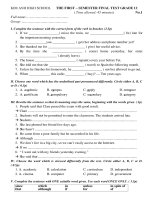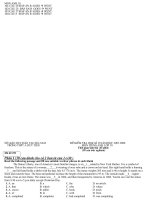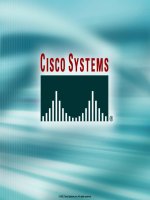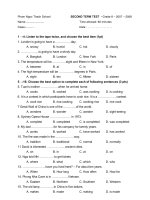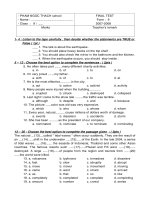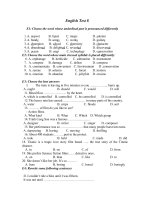Wastewater management final digital
Bạn đang xem bản rút gọn của tài liệu. Xem và tải ngay bản đầy đủ của tài liệu tại đây (3.49 MB, 56 trang )
Winery Process Wastewater
Management Handbook:
Best Practices and Technologies
February 2018
COPYRIGHT
Copyright 2018, Sustainable Winegrowing British Columbia. All rights reserved. No part of this
publication may be added to, deleted, reproduced, stored in a retrieval system, or transmitted, in any
form or by any means whatsoever, without prior permission from Sustainable Winegrowing
British Columbia.
Acknowledgments
This handbook was prepared by Kellie Garcia, P.Ag., of Insight Environmental
Consulting, with writing assistance from Theresa Loewen, P.Ag., and technical
input from Jeffrey Oland, P.Eng., of Oland Engineering Ltd. and John Garn
and Anna Britain of ViewCraft. Graphic design by Fetch Media.
The Water & Wine and Water & Beer online platforms developed by The
Bloom Centre for Sustainability (BLOOM) were important sources for this
handbook. The platforms are designed for Ontario winemakers and brewers,
but contain a plethora of information that is directly relevant to their
counterparts in British Columbia. Thank-you to BLOOM and their partners
for developing and sharing these valuable resources.
Funding provided by:
Funding for this handbook was provided in part by the BC Wine Grape Council and in part by the
Governments of Canada and British Columbia under Growing Forward 2, a federal-provincialterritorial initiative.
Disclaimer: Agriculture and Agri-Food Canada and the B.C. Ministry of Agriculture are pleased to participate in the
production of this publication. We are committed to working with our industry partners to address issues of importance
to the agriculture and agrifood industry in British Columbia. Opinions expressed in this publication are those of the
SWBC and not necessarily those of Agriculture and Agri-Food Canada and the B.C. Ministry of Agriculture.
Table Of Contents
INTRODUCTION
1
1
About the Handbook
Purpose
1
1
Organization and scope
About Sustainable Winegrowing British Columbia
2
Our Vision
2
2
Other SWBC resources
THE BASICS
3
What is winery wastewater?
3
What are the benefits of good water and wastewater management?
5
HOW TO...
7
8
Know your operation: planning and evaluation
Step 1: Prepare diagrams to see the big picture
Step 2: Monitor water consumption and wastewater production
11
Step 3: Identify hotspots
15
Step 4: Identify root causes
16
Step 5: Set goals and targets
17
Use less water and keep solids and chemicals out of your drains
Cleaning and sanitation
10
19
20
Crush pad
21
Barrels
22
Tanks and transfer lines
22
Clarification, filtration and bottling
23
Lees, pomace and other solids
23
Winery design
24
25
Water recycling and reuse
Select a suitable treatment system
27
Wastewater treatment basics
28
Traditional treatment systems
30
Examples of innovative treatment technologies
31
Factors to consider when choosing a system
35
Examples of wastewater treatment systems being used by British
Columbia wineries
38
Initiate change and build internal support
43
Seek management commitment
43
Engage people at all levels of the organization
43
Focus on training and education
44
Recognize and celebrate successes
44
Make water visible
44
Set clear goals and targets and measure performance
44
LIST OF RESOURCES FOR WINERY WASTEWATER MANAGEMENT
45
Winery Process Wastewater Management
INTRODUCTION
About the Handbook
Purpose
British Columbia has seen intense growth of its wine industry over the last decade. The number of
grape wine wineries more than doubled from 134 in 2007 to 275 in 2017, and grape wine production
was estimated at 21.3 M litres in 2015.1 Increased wine production has amplified the need for tools,
technologies, and practical guidelines for the management of winery wastewater.
Some BC wineries are facing wastewater challenges that are adding costs and operational risks to
their businesses. Challenges include inadequate system sizing leading to more frequent need for
cleaning or system failure, wastewater strength being too high for municipal treatment, clogged
dispersal systems (e.g. drywell), and odours. With the industry expected to grow and mature in the
coming years, water conservation and wastewater reuse topics are already, and will continue to be, of
interest and importance to the industry.
This handbook provides BC wineries with the latest information on best practices and technologies
that will help in the sustainable management of their source water and process wastewater, with the
ancillary benefits of increasing energy efficiency.
Organization and scope
The handbook is organized into three sections.
The “The Basics” section provides an overview of the unique characteristics of winery process
wastewater and discusses the benefits of good water and wastewater management.
The “How To” section outlines a 5-step approach to understanding your water use and wastewater
generation, provides best practices for using water more efficiently and improving the quality of
wastewater produced, and discusses the fundamentals of wastewater treatment and discharge, and
how to make good wastewater management “business as usual.” Case studies throughout the “How
To” section illustrate what BC wineries are doing to use water efficiently and reduce the strength of
their wastewater, and what treatment and discharge systems are in use.
The “List of Resources” section provides a list of important handbooks, websites, and other resources
related to winery wastewater management.
1
BC Wine Institute. 2017. Quick Facts - />
1 | sustainablewinegrowingbc.ca
Best Practices and Technologies
About Sustainable Winegrowing British Columbia
Sustainable Winegrowing British Columbia (SWBC) offers free access
to online assessments and educational resources and training to help
vineyards and wineries establish sustainable practices, share knowledge,
and measure and demonstrate ongoing improvement. SWBC was
created by a team of BC viticulturists, grape growers, winemakers,
hospitality directors, researchers, and sustainability and marketing
specialists, who gathered local knowledge and expertise and learned from
programs in other winegrowing regions.
Our Vision
Sustainable winegrowing is not only relevant for today, but also important for the future. Sustainable
practices help us make outstanding wines while protecting our bottom line, preserving the beauty and
health of our environment for future generations, and enhancing our relationships with employees,
neighbours, and consumers.
Our Vision is to be good stewards of the land, while enhancing the social and cultural value of
the wine and grape industry, and improving its economic viability - for tomorrow, next week,
next year, next decade, and next century.
Other SWBC resources
This handbook is one of many resources produced by SWBC to help vineyards and wineries become
leaders in sustainability. Other SWBC resources include:
• Sustainable practices guidebooks, checklists, and templates for vineyards, wineries, and
winery hospitality services
• Secure online assessment tool for members to evaluate their operations, create visual
reports, and prepare a sustainability action plan
• Annual progress reports
• Performance metric tools
• Fact sheets
To view all products, go to: www.sustainablewinegrowingbc.ca.
February 2018 | 2
Winery Process Wastewater Management
THE BASICS
What is winery wastewater?
Water is a key resource, used throughout the winemaking process from vineyard to bottle - for
irrigation, temperature control, cleaning, sanitation, sterilization, and filter rinsing. Wastewater is
simply water plus anything else that is put down the drain. Things that go down the drain in a winery
can include unused grapes and juice, winemaking remnants such as alcohol and sugars, and chemicals
such as cleaning agents. Winery wastewater contains inorganic salts, organic compounds, yeast,
and bacteria. The “high-strength” winery process wastewater (i.e. having more than 7,000 mg/L of
BOD, with a TSS of over 3,000 mg/L) has unique characteristics that differ significantly from other
food processing wastewaters.
Some factors to watch for in winery wastewater are2:
• Chemical (or Biochemical) Oxygen Demand (COD and BOD)
• Total suspended solids (TSS) and total dissolved solids (TDS)
• Salts such as sodium (Na), calcium (Ca), magnesium (Mg), and potassium (K)
• Salinity (electrical conductivity)
• Nutrients such as nitrogen and phosphorus
• Acidity or alkalinity (pH)
• Dissolved oxygen levels (DO)
Wastewater characteristics vary from winery to winery and appear to be significantly influenced by
climate and wine type produced. Wastewater loads also vary seasonally, with the highest organic
loads produced during vintage.
Grape and Wine Research and Development Corporation. 2011. Winery Wastewater Management & Recycling
Operational Guidelines.
2
3 | sustainablewinegrowingbc.ca
The Basics | Best Practices and Technologies
Cleaning waste is by far the biggest contributor of wastewater because it is generated at every
processing stage during wine manufacture.
Cleaning water can be classified as caustic, acidic, and rinsewater. Caustic cleaning agents are most
commonly used to dissolve solid deposits of tartrate, pigments, tannins and proteins. Acidic cleaning
agents such as dilute solutions of citric and/or tartaric acids are then used to remove caustic residues.
Following the caustic/citric washing, water is used to rinse away traces of the cleaning agents. It’s
important to note that one-process, non-caustic cleaners such as Cleanskin and Bevsan are now
being used by wineries in BC.
Processes associated with wine clarification and stabilization may also produce wastewater.
This includes regeneration of earth drum filters and ion exchange columns and the use of evaporative
cooling towers.
TYPICAL WASTEWATER DISTRIBUTION AT A WINERY3
SOURCES/PROCESS
VOLUME (%)
Rinsewater
43
Caustic washing
33
Earth filtration
15
Cooling tower
6
Ion exchange
3
Chapman, J,. P. Baker, and S. Wills. 2001. Winery Wastewater Handbook: Production, Impacts and Management. Winetitles,
South Australia.
3
February 2018 | 4
Winery Process Wastewater Management
What are the benefits of good water
and wastewater management?
Wastewater management is inextricably linked to efficient winery operations and long-term profit.
It is as much a business matter as an environmental or technical issue.
Benefits of effectively managing water and wastewater include:
• Reduced operational costs,
• Reduced time and labour costs from improved cleaning procedures,
• Better production efficiency,
• Reduced water supply costs, wastewater disposal fees, or surcharges,
• Avoidance of environmental harm, and
• Enhanced relationships and reputation with consumers, local community and regulators.
Furthermore, there is a growing market demand for sustainable wine production, and managing water
resources effectively and preventing pollution is part of that equation.
Wineries can stay ahead of the game by integrating management strategies before regulations
or emergencies (e.g. failed system) demand a quick response. This allows the freedom to choose
practices and technologies that make the most economic sense for the business and implement them
over a time period that is manageable for the winery.
Photo Credit: Wines of British Columbia, WineBC.com
5 | sustainablewinegrowingbc.ca
The Basics | Best Practices and Technologies
Good wastewater management helps keep the environment safe and your
neighbours happy.
Most wineries in BC do not have sophisticated wastewater treatment systems to deal with their highstrength wastewater; in most cases, the untreated or marginally-treated wastewater is discharged
into leach fields, infiltration ponds, or dry wells. This makes it even more important for wineries to
make sure the strength and quantity of their wastewater is closely managed.
When winery wastewater is discharged onto soil, it can lead to increased salinity and acidity, which
are detrimental to vegetation growth and soil biota. It can also have a detrimental effect on surface
and groundwater ecosystems, from increased microbial and algal growth that consume the available
oxygen necessary for other organisms to survive.
Wastewater treatment processes can also generate nitrous oxide, which is a significant greenhouse
gas. In addition, high strength wastewater that is directly applied to the vineyard can stimulate soil
microbes, thereby increasing the amount of nitrous oxide released to the atmosphere.
Good wastewater management will also reduce the risk of odours, which are often caused by loading
large amounts of organic materials in the wastewater, or treatment systems that are over-capacity or
not operating properly. Odours can impact neighbours, winemaking, and tasting experiences.
Photo Credit: Alison Thorpe
February 2018 | 6
Winery Process Wastewater Management
HOW TO…
This section presents detailed information to assist wineries in carrying out comprehensive planning
and evaluation of their operations, improve operating practices to use water more efficiently and
reduce wastewater load, and select appropriate treatment processes and technologies.
Section Overview
Know your operation: planning and assessment outlines a 5-step approach to understanding
water use and wastewater generation at your winery. When water use and waste streams are well
understood, it is possible to consider what can be done in the winery to improve the quality of the
wastewater and reduce its quantity.
Use less water and keep solids and chemicals out of your drains provides best practices for using
water more efficiently and improving the quality of wastewater produced. Case studies are provided
to highlight the source reduction practices at five BC wineries.
Select a suitable treatment system discusses the fundamentals of wastewater treatment and factors
to consider when choosing a system. Examples of new and innovative treatment technologies are
provided to highlight what is being done elsewhere. Case studies are provided to show the treatment
and discharge systems at five BC wineries, highlighting the opportunities and challenges with each
type of system.
Initiate change and build internal support provides guidance on how to make good wastewater
management an integral part of your operations by engaging people at all levels of the organization,
training and educating all staff, and measuring and celebrating progress.
7 | sustainablewinegrowingbc.ca
How To... | Best Practices and Technologies
Know your operation: planning and evaluation
KEY POINTS:
•To make informed and cost-effective improvements to your processes,
you need a good understanding and a baseline of how you use water and
generate wastewater.
•The source, volume and quality of wastewater – and how that varies
during vintage and non-vintage – must all be considered.
You can use a 5-step process to get a better understanding of your water use
and wastewater composition and identify the best ways to make improvements.
Step 1:
Prepare a flow diagram to see the big picture
Step 2:
Monitor water consumption and wastewater production
Step 3:
Identify hotspots
Step 4:
Identify root causes
Step 5:
Set goals and targets
February 2018 | 8
Winery Process Wastewater Management
KEY QUESTIONS TO ANSWER:
• How much water is used in each operation at your winery?
• Equipment cleaning and sanitation
• Cellar cleaning and sanitation
• Process (crush pad, wine movements, press operations)
• Lab
• Tasting room, kitchen, bathrooms
• Boilers
• Evaporative cooling towers
• Water softening
• Bottling
• Landscaping
• How much wastewater is collected and/or discharged at your winery?
• Wastewater sump
• Wastewater collection system – intermediate points
• Wastewater reclamation for reuse
• Septic system for sanitary wastewater
• Stormwater runoff
• Process water runoff
• Discharge methods
• Digester
• What are the sources of wastewater generated at your winery?
• What is the capacity of your wastewater containment and discharge?
• What types of housekeeping practices are used to conserve water and limit the quantity of
wastewater generated?
• What types of process controls are used to improve process efficiency?
• Are any of the wastewater streams classified as hazardous? What characteristics make them
hazardous?
• What regulatory permits are required for your wastewater system and discharge?
• What wastewater monitoring and treatment is necessary to comply with regulations?
9 | sustainablewinegrowingbc.ca
How To... | Best Practices and Technologies
Step 1:
Prepare a flow diagram to see the big picture
Thinking about wastewater begins with thinking about winemaking. What happens in the winery
dictates the effluent that is produced, which in turn determines the type of treatment required and
influences how well the waste treatment system functions, which in turn controls the end use to
which the effluent may be applied.4
Prepare a flow diagram of your inputs and outputs. Winemaking typically involves receiving grapes,
crushing and pressing, processing, and bottling. Each process has associated inputs and outputs.
Inputs will include grapes, must, wine, chemicals used for filtration, ion exchange, sanitation and
cleaning, and water. Outputs include things like suspended solids, grape solids, tartrate solids,
dissolved sugar, sodium and potassium.
EXAMPLE PROCESS FLOW DIAGRAM
INPUTS
PROCESSES
OUTPUTS
Grape receival
Suspended Solids
Crush, Ferment, Press
Suspended Solids
Grape Solids
Dissolved Sugar
Wine
Sodium, Potassium
Tartaric Acid
Diatomaceous Earth
Pearlite
Caustic Cleaning Agents
Clarification & Acid Adjust
Suspended Solids
Grape Solids
Dissolved Sugar
Wine
Media Solids
Sodium, Potassium
Caustic Cleaning Agents
Maturation
Tartrate Solids
Sodium, Potassium
Caustic Cleaning Agents
Stabilization
Tartrate Solids
Finishing Agents
Sodium, Potassium
Caustic Cleaning Agents
Filtration
Tartrate Solids
Grape Solids
Sodium, Potassium
Caustic Cleaning Agents
Blending
Sodium, Potassium
Caustic Cleaning Agents
Copper
Wine Storage
Wine (push throughs)
Sodium, Potassium
Balancing
Suspended Solids
(filtration)
Sodium
Grapes
Tartaric Acid
Sulphur
Caustic Cleaning Agents
Caustic Cleaning Agents
Bottling
Sodium, Potassium
Grape and Wine Research and Development Corporation. 2011. Winery Wastewater Management and Recycling
Business Fundamentals.
February 2018 | 10
4
Winery Process Wastewater Management
Step 2:
Monitor water consumption and wastewater production
Data on water use and wastewater generation can be used to establish baselines, benchmark
performance, identify opportunities for improvement and better plan for growth. What you want to
achieve will determine what level of monitoring you need to do. You can:
• Monitor total water consumption by collecting data from water bills or reading the municipal
water meter weekly, monthly, or more frequently during periods of high water use.
• Monitor how much water is used in different operations by installing meters at key points in
the winery, like where a water line splits between production and hospitality.
• Monitor how much water is used by different activities, like washing barrels and cleaning of
the crush pad, by installing point-of-use meters at faucets and hoses (for example). This level
of monitoring will enable you to better identify hot spots (Step 3).
Determine metering requirements and locations
A plumbing diagram can be created for the winery that illustrates how water moves through the
facilities and identifies the appropriate locations to install meters to track water use. The plumbing
diagram should include:
• Source(s) of water such as wells and municipal connections
• Piping sizes and materials
• Treatment equipment such as filtration, disinfection, or water softening
• Points of use including taps, washrooms, sinks, and other fixtures
PLUMBING DIAGRAM EXAMPLE
RESIDENCE
PRODUCTION
HOSPITALITY
KITCHEN
WC
KITCHEN
WELL
TASTING
ROOM
WC
HWT
1
WC
HWT
CRUSH
PAD
UV
Hose used for wine production
CISTERN
ABOVE GROUND
STORAGE TANK
Hose used for landscaping
Hose used for barrel & press cleaning
UV
HOUSE
CRUSH
PAD
LEGEND
1” PVC Pipe
Hose used for barrel cleaning
Micro-filtration and UV disinfection
1 1/2” Tri-Clamp Hose
Drilled well is the primary water supply
3/4” Copper Pipe
Above-ground storage tank holds trucked-in
water to supplement well supply
Source: BLOOM Water & Wine online platform: />11 | sustainablewinegrowingbc.ca
How To... | Best Practices and Technologies
Select and install meters
Water meters can be installed permanently in-line or on water fixtures such as hoses or taps. Where
possible, locate meters in easily accessible but protected locations and on smaller diameter copper
pipes. In-line meter costs increase significantly for pipes larger than 1.5”. It may be cheaper to install
multiple meters on smaller pipes than one meter on a larger pipe.
The most cost-effective in-line meter is a simple paddle wheel accumulator that measure total water
flow. They start at around $80 for a ¾” plastic paddle wheel model; prices increase with pipe size. The
meters can be purchased on-line from water meter suppliers, or through local plumbers. They are
relatively easy to install, taking between 15-30 minutes per meter. It is easiest if the water supply is
shut off so plan installation for a time that will not impact winery operations. Ensure proper sanitation
is practiced so as not to contaminate the drinking water.
Hose meters can be used to monitor water use at the point of use. They can simply be screwed on to
existing hose bibs or faucets. The meters can often be found in hardware or gardening stores and cost
from $20-$60. Plastic hose meters may be damaged through rough handling of hoses. Use a hose
kink protector or something that restricts hose movement at the meter to protect it from damage.
More durable metal hose meters are also available for additional cost. Hose meters must be removed
from outside fixtures and brought indoors during sub-freezing temperatures.
IN-LINE METER
HOSE METER
Photo credits: BLOOM Water & Wine online platform: />
February 2018 | 12
Winery Process Wastewater Management
Collect water data
Operational data should be recorded at least monthly. During periods of high water use, such as
harvest, data should be collected daily or weekly.
Create a tracking sheet to record your data (or download from omcentre.
com/modules/water-use-monitoring/collecting-data/#tab-id-2).
MeterDescriptions
MeterNumber MeterType
Meter1
In-line
Meter2
In-line
Meter3
In-line
Meter4
Hosemeter
Meter5
Hosemeter
Meter6
Hosemeter
Meter7
Hosemeter
Date
Time
OPERATIONAL WATER USE TRACKING
WaterMeasured
Totalwaterconsumption
Totalwaterusedinproductionandhospitality
Totalwatersuppliedfromabove-groundtank
Waterusedinwineproduction(interior)
Waterusedforlandscaping(patio)
Waterusedinwineproduction(maincrushpad)
Waterusedinwineproduction(crushpadathouse)
Meter1
(litres)
Meter2
(litres)
Meter3
(litres)
MeterReadings
Meter4
(litres)
Meter5
(litres)
Source: BLOOM Water & Wine online platform: />
TIP
It is good practice to occasionally record
the reading on meters before or after a
period of inactivity (such as overnight) to
identify any unexpected water use, which
could indicate leaks or faulty equipment.
13 | sustainablewinegrowingbc.ca
Meter6
(litres)
Meter7
(litres)
How To... | Best Practices and Technologies
Activity data should be tracked daily or as actions are undertaken using tracking sheets posted
near water fixtures. Activities to track include barrel cleaning and sanitation, barrel hydration, tank
cleaning and sanitation, press/crusher cleaning and sanitation, filter cleaning and sanitation, and
bottling.
Create a tracking sheet to record your data (or download from omcentre.
com/modules/water-use-monitoring/collecting-data/#tab-id-3).
ACTIVITY WATER USE TRACKING
Landscaping
GeneralSanitation
Bottling
FilterCleaning&Sanitation
Hose/LineCleaning&Sanitation
Press/CrusherCleaning&Sanitation
TankCleaning&Sanitation
BarrelHydration
Date
BarrelCleaning&Sanitation
Activity
InitialMeter
Reading(L)
FinalMeterReading
(L)
ActivityDetails
(e.g.#ofbarrelswashedorhydrated,tanks
cleaned,bottlesfilled,etc)
Employee
Initials
Source: BLOOM Water & Wine online platform: />
TIP
The California Sustainable Winegrowing Alliance has also
developed an Excel-based “Winery Water Efficiency and Hot
Spot” data tracking spreadsheet. It’s available for download at:
/>
February 2018 | 14
Winery Process Wastewater Management
Step 3:
Identify
hotspots
Tackle the source not the symptoms. There are common hotspots in a winery that are major
contributors to volume of water used and wastewater strength. They represent areas where
winemakers and employees can focus and prioritize their efforts to be more water efficient. The
diagrams prepared in Step 1 and the data collected in Step 2 can be used to identify the hotspots in
your winery.
Common hot spots wineries can look at for improvements that will have the most impact:
• General water use activities - Cleaning transfer lines and washing floors, walls, and ceilings
often doesn’t consume a lot of water at once, but these activities occur frequently so small
improvements can have a large impact.
• Barrel cleaning and sanitation – This is one of the largest water-using activities in a winery
and presents a significant opportunity for water savings through process improvements and
the use of water-efficient equipment.
• Barrel hydration – Changes to barrel hydration practices is one of the easiest ways to
achieve low-cost water savings.
• Cleaning and sanitizing tanks, presses, crushers, and other equipment – This is another
one of the largest uses of water in the winery; therefore, improved practices can reduce the
amount of water used and the strength of wastewater.
• Bottling – There are many opportunities to reduce the amount of time and water used to
clean and fill bottles.
• Solids management – Improving solids management is an essential component of reducing
wastewater strength; wineries can reduce the strength of their wastewater by 90% by
diverting organic material such as pomace and lees out of the water system. This aids in not
overloading the septic system.
15 | sustainablewinegrowingbc.ca
How To... | Best Practices and Technologies
Step 4:
Identify root causes
Once a winery has identified hot spots, they must investigate the root causes of the hot spots (i.e.
why inefficient water use is taking place and why materials are entering the wastewater stream).
Ask the question “why” to uncover behaviours, actions, inactions, or conditions that are leading to
unnecessary water use or wastewater loading. Include employees in the discussion because they will
have important insight into the day-to-day operations.
EXAMPLE: DETERMINING ROOT CAUSES IN A SAMPLE WINERY
The winery was
interested in
understanding
why so much more
water was used to
clean the cellar
floors compared
to the floors in the
production room.
The winery
brought together
their employees
to investigate why
this was the case.
They ended up
identifying the
root causes.
Why is so much water used to
clean the cellar floor?
It takes a long time to
clean and hoses are left
running the entire time.
Why does it take so long?
Why are hoses left running when
employees are trained to only turn
them on when needed?
It takes a long time to clean
The floor is rough and it requires
a lot more scrubbing and rinsing.
The tap for the hose is far away from
where most of the cleaning takes place
and there are barrels in the way
Why is the floor so rough?
Why is it so difficult to turn
off the hoses?
It does not have an epoxy finish
like the other floors in the winery
The hoses don’t have shut-off nozzles
like in the production room.
Source: BLOOM Water & Wine online platform: />
February 2018 | 16
Winery Process Wastewater Management
Step 5:
Set goals and targets
Operational and activity metrics (or key performance indicators) should be developed and used
to estimate future consumption and wastewater generation, facilitate regulatory approvals and
inspections, and compare performance over time and against industry benchmarks.
Water-to-wine ratio and peak daily water use are examples of operational metrics. Create a tracking
sheet to record your data (or download from />
OPERATIONAL KEY PERFORMANCE INDICATORS
KeyPerformanceIndicatorscanbecalculatedbycombiningwaterusedatawithdataonwineproductionandnumberofvisitors.
Peakwastewatergenerationcanbedeterminedthroughdailymeasurementsofwaterconsumptionduringharvest.
Ifdailydataisnotavailable,anestimatecanbeobtainedbydividingthevolumeofwaterusedoveragivenperiodbythenumberofdayscoveredbytheperiod.Thelongerthe
periodcoveredbyasinglemeterreading,thelessaccuratetheestimateofpeakdailywastewatergenerationwillbe.
KeyPerformanceIndicators
Year
Water-to-WineRatio
WaterConsumedperVisitor(litres/visitor)
WaterConsumedperRestaurantPatron(litres/visitor)
WaterConsumedperAccomodationsGuest(litres/visitor)
DailyPeakWastewaterGeneration(litres)
TotalWaterConsumption(litres)
Year1
Year2
Source: BLOOM Water & Wine online platform: />
TIP
The BLOOM Water and Wine platform
includes a Production Calculator in
its Water Use Monitoring module.
According to the calculator, the industry
benchmark water-to-wine ratio is 3:1 to
10:1 and for peak daily water use is
2 – 5% of production volume.
17 | sustainablewinegrowingbc.ca
Year3
How To... | Best Practices and Technologies
Activity metrics can be used to identify opportunities for improvement and support business cases
for strategic improvements and equipment upgrades. Examples of activity metrics are shown in the
tracking sheet below.
Create a tracking sheet to record your data (or download from omcentre.
com/modules/water-use-monitoring/key-performance-indicators/#toggle-id-1).
ACTIVITY KEY PERFORMANCE INDICATORS
ActivityKeyPerformanceIndicators
BarrelCleaning&Sanitation
AverageWaterUsedperBarrel(litres)
Max.WaterUsedperBarrel(litres)
Min.WaterUsedperBarrel(litres)
BarrelHydration
AverageWaterUsedperBarrel(litres)
Max.WaterUsedperBarrel(litres)
Min.WaterUsedperBarrel(litres)
TankCleaning&Sanitation(litres)
AverageWaterUsedperTank(litres)
Max.WaterUsedperTank(litres)
Min.WaterUsedperTank(litres)
PressandCrusherCleaning&Sanitation
AverageWaterUsedperCleaning(litres)
Max.WaterUsedperCleaning(litres)
Min.WaterUsedperCleaning(litres)
Bottling
AverageWaterUsedperBottle(litres)
Max.WaterUsedperBottle(litres)
Min.WaterUsedperBottle(litres)
Datashouldbekeptovertimetocompareperformanceyear-to-year
Year1
Year2
Year3
Year4
Source: BLOOM Water & Wine online platform: />
Initial measurement of your key performance indicators will establish operational baselines from
which you can set goals and gauge progress over time. Wineries should track the indicators year-toyear to see if and what improvements they are making.
Source: BLOOM Water & Wine online platform: />
February 2018 | 18
Winery Process Wastewater Management
Use less water and keep solids and
chemicals out of your drains
KEY POINTS
• Tackle the source, not the symptoms.
• Improving the wastewater quality of any winery operation depends on understanding
both the quantity of process water being generated and the quality of that water.
• Two-thirds of all water used in a winery is for cleaning and sanitation: start here first.
• Simply reducing your water use does not improve the quality of the process water and
can concentrate organics and inorganics, degrading the quality of the process water
further.
• Cleaner production practices that stop solids and other contaminants from going down
the drain, reduce water use, and segregate wastes (especially strong wastes) are key.
• It is always more cost effective not to generate waste than to spend energy to remove it.
Low-to no-cost best practices include:
• Track and monitor water use
• Prepare and follow standard operating procedures (SOPs) for cleaning and sanitation
activities
• Provide employee education, training and incentives
• Provide employees with enough of the right tools (e.g. timers on hoses, spray nozzles,
brooms, and squeegees)
• Patrol and fix leaks
TIP
Focusing only on reducing water use without reducing wastewater loading can
result in higher wastewater concentrations. The concentration of your wastewater
is a product of your loading divided by your volume.
19 | sustainablewinegrowingbc.ca
How To... | Best Practices and Technologies
Cleaning and sanitation
• Use brushes, brooms and/or squeegees to pre-clean equipment, tanks, and floors before
using water. Colour code your brushes to emphasize their use and make it easier on your
employees, and organize the brushes and cleaning materials on a cart with wheels to allow for
movement throughout the facility.
• Use high pressure nozzles with automatic shut off whenever possible.
• Use PIGs instead of flushing with large amounts of water. PIGs (pipeline inspection gauges)
are inserted into transfer lines and pressure-driven through the pipeline along with the wine
and/or water using compressed gas such as nitrogen.
• Develop standard operating procedures for washing barrels, cleaning and sanitizing tanks and
equipment, and other processes. Post the procedures where employees can see them and
provide training and regular refreshers.
• Capture, filter and reuse cleaning solutions.
• Consider ease of cleaning when purchasing new equipment.
• Use sanitation methods and products that don’t require a final rinse. Examples include
Cleanskin and Bevsan.
• Evaluate whether ozone could be substituted for the final rinse. Ozone offers higher
sanitization quality, time and energy savings and decreased chemical use. Typical applications
for ozone include: barrel washing, surface and equipment sanitization, tank cleaning, and
clean-in-place of process and transfer piping.
• Automate sanitization procedures or set cleaning times.
• Substitute steam cleaning for individual sanitation steps or throughout the winery.
TIP
Photo credit: BLOOM Water & Wine online platform:
/>
Automate Cleaning and Recycle Water
Where You Can. Using an automated
or semi-automated cleaning system
such as clean-in-place (CIP) for tanks
and bottling lines can reduce water and
chemical use by up to 50% while ensuring
more consistent results. These systems
can also reuse water in cleaning cycles,
significantly reducing water use and costs.
Many options are available, from semiautomated systems to mobile CIP carts to
fully-integrated CIP systems.
February 2018 | 20
